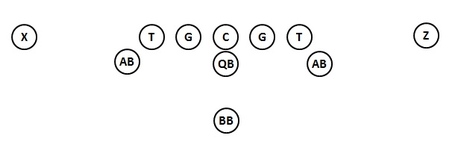Inside Veer: The inside veer read key is the first down DL past the Guard. A rule of thumb is that option teams like to run veer to the 1-technique side of an even front. For us, this means that the playside G and C will double team the N and try to widen the path for the FB. Some teams have gone to a zone scheme on this block, scooping the N to a LB, but in either case we will treat that initial block as a double team. Now, the QB will look to read the next man past the G (some teams will wash a 4i-technique). For us, that's our Rip DE. The OT will release inside by dipping his shoulder to avoid contact with the 5-technique DE - his job is to seal the frontside LB. The QB then reads the action of the DE: if he closes on the FB the QB will pull the ball and attack the next defender outside. If the DE sits, hesitates, or flies upfield, the QB will give the ball to the FB and the FB will attack the B-gap full speed. Make no mistake, option teams want their FB running full speed ahead with the ball. On the backside, the G and T will look to cut off any penetration to their playside gaps and then climb to the second level and pick off pursuing LB's.

Outside Veer: Outside veer is run outside of the tackle box. Most teams will only run outside veer with a TE in the game, but we have had teams run it out of the flexbone formation (see previous post about the flexbone formation) against us. The OT and wingback/slotback or the OT and TE will double team the DE (5 tech vs flexbone, 7 tech vs TE). The QB then reads the next defender past the DE for his give/pull read. The FB attacks C gap, as opposed to B gap for inside veer. The rest of the OL will seal their playside gaps and climb to the second level, sort of like an outside zone play. If you want to see film of the outside veer, watch the game film from last year (2015) vs. Berkley. They ran outside veer a few times in the 2nd and 3rd quarters.
Triple option teams want to establish their FB. If Midline isn't there, they go to Inside Veer, and if that's not there they go to Outside Veer. That's their thing. They complement their option stuff with trap, a counter option, and rocket toss (quick pitch), as well as some play action passing. There's a lot of great video online of Navy and Georgia Tech running this offense. We also have game films on Hudl from Berkley and Seaholm the past 2 seasons. Watch, learn, and get better! Next time we'll start to look at pro-style offenses.

